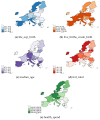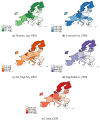Challenges and Drawbacks of the EU Medical System Generated by the COVID-19 Pandemic in the Field of Health Systems' Digitalization
- PMID: 35564345
- PMCID: PMC9100197
- DOI: 10.3390/ijerph19094950
Challenges and Drawbacks of the EU Medical System Generated by the COVID-19 Pandemic in the Field of Health Systems' Digitalization
Abstract
The COVID-19 pandemic and the digitalization of medical services present significant challenges for the medical sector of the European Union, with profound implications for health systems and the provision of high-performance public health services. The sustainability and resilience of health systems are based on the introduction of information and communication technology in health processes and services, eliminating the vulnerability that can have significant consequences for health, social cohesion, and economic progress. This research aims to assess the impact of digitalization on several dimensions of health, introducing specific implications of the COVID-19 pandemic. The research methodology consists of three procedures: cluster analysis performed through vector quantization, agglomerative clustering, and an analytical approach consisting of data mapping. The main results highlight the importance of effective national responses and provide recommendations, various priorities, and objectives to strengthen health systems at the European level. Finally, the results reveal the need to reduce the gaps between the EU member states and a new approach to policy, governance, investment, health spending, and the performing provision of digital services.
Keywords: COVID-19; European Union; data mapping; digitalization; health; method of vector quantization.
Conflict of interest statement
The authors declare no conflict of interest. The research was conducted in the absence of any commercial or financial relationships that could be construed as a potential conflict of interest.
Figures













Similar articles
-
Opportunities for healthcare digitalization in Europe: Comparative analysis of inequalities in access to medical services.Health Policy. 2024 Jan;139:104950. doi: 10.1016/j.healthpol.2023.104950. Epub 2023 Dec 1. Health Policy. 2024. PMID: 38061175
-
The European Union and Public Health Emergencies: Expert Opinions on the Management of the First Wave of the COVID-19 Pandemic and Suggestions for Future Emergencies.Front Public Health. 2021 Aug 20;9:698995. doi: 10.3389/fpubh.2021.698995. eCollection 2021. Front Public Health. 2021. PMID: 34490183 Free PMC article.
-
Italy: Health System Review.Health Syst Transit. 2022 Dec;24(4):1-236. Health Syst Transit. 2022. PMID: 36951263
-
Accelerated Digitalization of the Epidemiological Measures: Overcoming the Technological and Process Complexities of Establishing the EU Digital COVID Certificate in Slovenia.Int J Environ Res Public Health. 2022 Nov 2;19(21):14322. doi: 10.3390/ijerph192114322. Int J Environ Res Public Health. 2022. PMID: 36361204 Free PMC article. Review.
-
Medical Liability of the Vaccinating Doctor: Comparing Policies in European Union Countries during the COVID-19 Pandemic.Int J Environ Res Public Health. 2022 Jun 11;19(12):7191. doi: 10.3390/ijerph19127191. Int J Environ Res Public Health. 2022. PMID: 35742438 Free PMC article. Review.
Cited by
-
Mental Health Professionals' Attitudes Toward Digital Mental Health Apps and Implications for Adoption in Portugal: Mixed Methods Study.JMIR Hum Factors. 2023 Jun 2;10:e45949. doi: 10.2196/45949. JMIR Hum Factors. 2023. PMID: 37266977 Free PMC article.
-
Measuring Health Inequalities Using the Robin Hood Index: A Systematic Review with Meta-Analysis.Epidemiologia (Basel). 2025 Jul 10;6(3):35. doi: 10.3390/epidemiologia6030035. Epidemiologia (Basel). 2025. PMID: 40700107 Free PMC article. Review.
-
Big Data, Decision Models, and Public Health.Int J Environ Res Public Health. 2022 Jul 13;19(14):8543. doi: 10.3390/ijerph19148543. Int J Environ Res Public Health. 2022. PMID: 35886394 Free PMC article.
-
Identification of new pharmacophore against SARS-CoV-2 spike protein by multi-fold computational and biochemical techniques.Sci Rep. 2024 Feb 13;14(1):3590. doi: 10.1038/s41598-024-53911-6. Sci Rep. 2024. PMID: 38351259 Free PMC article.
-
"I'm still struggling with it, and it scares me": A qualitative analysis of older adults' experiences with digital health portals during and after COVID-19.Digit Health. 2024 Sep 25;10:20552076241282247. doi: 10.1177/20552076241282247. eCollection 2024 Jan-Dec. Digit Health. 2024. PMID: 39372805 Free PMC article.
References
-
- Thomson S., Foubister T., Mossialos E. Financing Healthcare in European Union, Challenges and Policy Responses. World Health Organization; Geneva, Switzerland: 2009. [(accessed on 16 February 2022)]. Available online: https://apps.who.int/iris/handle/10665/326415.
-
- Wendt C., Kohl J., Mischke M., Pfeifer M. How Do Europeans Perceive Their Healthcare System? Patterns of Satisfaction and Preference for State Involvement in the Field of Healthcare. Eur. Sociol. Rev. 2010;26:177–192. doi: 10.1093/esr/jcp014. - DOI
-
- United Nations. [(accessed on 14 January 2022)]. Available online: https://www.un.org/ga/search/view_doc.asp?symbol=A/RES/70/1&Lang=E.
-
- National Institutes of Health. [(accessed on 24 February 2022)]; Available online: https://obssr.od.nih.gov/sites/obssr/files/Social-and-Behavioral-Theorie....
-
- Diffusion of Innovation Theory—SPH. [(accessed on 24 February 2022)]. Available online: https://sphweb.bumc.bu.edu/otlt/mph-modules/sb/behavioralchangetheories/....
Publication types
MeSH terms
LinkOut - more resources
Full Text Sources
Medical

